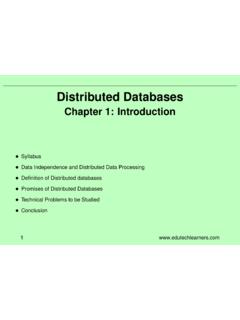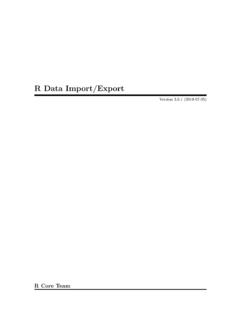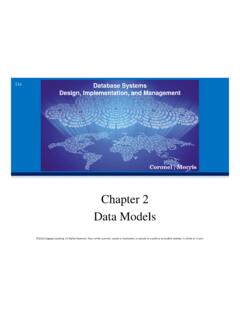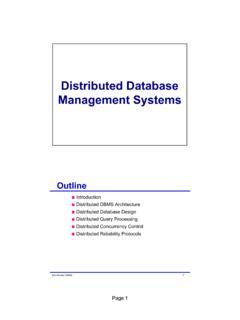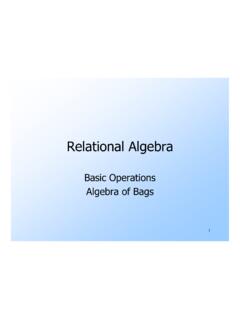Transcription of Tableau Tutorial - UMD
1 Tableau Tutorial User Documentation Archit Sood, Neha Sinha, Shashank Dewjee, and Wei Zhao 1 Table of Contents Introduction .. 2 Tableau desktop (Business analytics anyone can use) .. 2 Tableau server .. 3 Tableau online .. 3 Tableau public .. 3 Why should you use Tableau ? .. 4 VizQL .. 4 Advanced In-Memory Technology- The Data Engine .. 4 Evaluation of Tableau .. 5 Strengths .. 5 Speed .. 5 Ease of use .. 5 Beautiful and interactive dashboard .. 5 Direct connection .. 5 Easy publishing and sharing .. 5 Growing market .. 5 Weakness .. 6 Not comprehensive solution, specialize in BI .. 6 No predictive analytical capabilities .. 6 Customization and Integration with other apps .. 6 Expandability for analytics .. 6 Social media integration .. 6 Robust enterprise-class 7 Tips .. 7 7 Sample Data Sets.
2 9 Resources .. 9 2 Introduction In 2020 the world will generate 50 times the amount of data as in 2011. And 75 times the number of information sources (IDC, 2011). Within these data are huge, unparalleled opportunities for human advancement. But to turn opportunities into reality, people need the power of data at their fingertips. Tableau is building software to deliver exactly that. Tableau Software is an American computer software company headquartered in Seattle, WA, USA. It produces a family of interactive data visualization products focused on business intelligence. The company was founded at Stanford University s Department of Computer Science between 1997 and 2002. Professor Pat Hanrahan and student Chris Stolte who specialized in visualization techniques for exploring and analyzing relational databases and data cubes led research in the use of table-based displays to browse multidimensional relational databases.
3 Together, they combined a structured query language for databases with a descriptive language for rendering graphics and invented a database visualization language called VizQL (Visual Query Language). VizQL formed the core of the Polaris system, an interface for exploring large multi-dimensional databases. In 2003, after Stolte recruited his former business partner and friend, Christian Chabot, to serve as CEO Tableau was spun out of Stanford with an eponymous software application. The product queries relational databases, cubes, cloud database , and spreadsheets and then generates a number of graph types that can be combined into dashboards and shared over a computer network or the internet. In 2010, Tableau reported revenue of $ million dollars.
4 That figure grew to $ million in 2011 and $ million in 2012. Profit during the same periods came to $ million, $ million, and $ million, respectively. Shares of Tableau Software started trading on the New York Stock Exchange after an initial public offering on May 17, 2013 The different products which Tableau has built are: Tableau desktop (Business analytics anyone can use) Tableau Desktop is based on breakthrough technology from Stanford University that lets you drag & drop to analyze data. You can connect to data in a few clicks, then visualize and create interactive dashboards with a few more. We ve done years of research to build a system that supports people s natural ability to think visually. Shift fluidly between views, following your natural train of thought.
5 You re not stuck in wizards or bogged down writing scripts. You just create beautiful, rich data visualizations. 3 It's so easy to use that any Excel user can learn it. Get more results for less effort. And it s 10 100x faster than existing solutions Tableau server Tableau Server is a business intelligence application that provides browser-based analytics anyone can use. It s a rapid-fire alternative to the slow pace of traditional business intelligence software. What makes Tableau different? It's designed for everyone. There's no scripting required, so anyone can become an analytics expert. You can grow your deployment, as you need it. Train online for free. Find answers in minutes, not months. Tableau online Tableau Online is a hosted version of Tableau Server.
6 It makes rapid-fire business analytics easier than ever. Share dashboards with your whole company and with customers and partners in minutes. Provide live, interactive views of data that let people answer their own questions, right in a web browser or on a tablet. And do it in a secure, hosted environment. Tableau Online can scale up as much as you need and you can use it wherever you need it. You don't need to purchase, set up or manage any infrastructure. Tableau public Tableau Public is for anyone who wants to tell stories with interactive data on the web. It's delivered as a service that allows you to be up and running overnight. With Tableau Public you can create amazing interactive visuals and publish them quickly, without the help of programmers or IT.
7 The Premium version of Tableau Public is for organizations that want to enhance their websites with interactive data visualizations. There are higher limits on the size of data you can work with. And among other premium features, you can keep your underlying data hidden. Why tell stories with data? Because interactive content drives more page views and longer dwell time. Industry experts have cited figures showing that the average reading time of a web page with an interactive visual is 4, 5 or 6 times that of a static web page. 4 Why should you use Tableau ? There are many reasons why one should use Tableau they are It is very easy to use: You don t need to know programming of any sort, all you need is some data and Tableau to create reports that are visually enchanting and which tells a story which you need to tell ur managers or impress your professor in class.
8 With its revolutionary drag and drop feature u can easily create stories or reports using just your mouse and a little imagination. All this is possible due to the revolutionary VizQL a visual query language VizQL VizQL is a visual query language that translates drag-and-drop actions into data queries and then expresses that data visually. VizQL delivers dramatic gains in people s ability to see and understand data by abstracting the underlying complexities of query and analysis. The result is an intuitive user experience that lets people answer questions as fast as they can think of them. We believe that VizQL represents a foundational advancement in the area of data analysis and visualization. Jim Gray, a Turing Award winner and a legendary figure in the field of databases, wrote about VizQL in a research highlight: If you have ever been frustrated when trying to plot a useful graph from a simple spreadsheet, you would appreciate the value of a system that allows users to create stunning graphs interactively and easily from large multidimensional datasets.
9 The fundamental innovation is a patented query language that translates your actions into a database query and then expresses the response graphically. Because of VizQL, fast analytics and visualization are reality. People with little or no training can see and understand data faster than ever and in ways like never before. And that s the biggest difference of all. Advanced In-Memory Technology- The Data Engine Most of the data analytic software have a lot of fancy features but almost all of them fail when it comes to operating with large amounts of data, this is where the advanced in memory technology of Tableau is a savior to all of those who need to get reports from ever increasing data. The Tableau data engine is a breakthrough in-memory analytics database designed to overcome the limitations of existing databases and data silos.
10 Capable of being run on ordinary computers, it leverages the complete memory hierarchy from disk to L1 cache. It shifts the 5 curve between big data and fast analysis. And it puts that power into the hands of everyone. Ad-hoc analysis of massive data takes place in seconds. No fixed data model is required. To know more about these unique and advanced features of Tableau which separates it from its rivals please go thru this link: Evaluation of Tableau Strengths Speed The greatest strength of Tableau is its speed with which it analyzes hundreds of millions of rows and gives the required answers in seconds. This quality comes in very handy when fast business decisions need to be taken. Ease of use Another strength of Tableau is that it is very easy to use.
